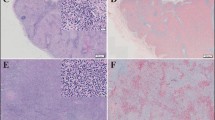Abstract
Background
M2 macrophages play a critical role in the recruitment of T helper 2 (Th2) regulatory T cells (Treg).
Objectives
To study the role of M2 macrophages and Treg cells in eosinophilic celulitis.
Material and Methods
We employed immunohistochemical staining for CD163 and CD206 (macrophages) as well as FoxP3 (Treg), in lesional skin of four cases of eosinophilic cellulitis.
Results
CD163+ CD206+ M2 macrophages, which were previously reported to produce CCL17 to induce Th2 cells and Treg cells, were predominantly infiltrating the subcutaneous tissues and interstitial area of the dermis. M2 macrophages derived from PBMC showed significantly increased expression of CCL11, CCL17, CCL24 and CCL26 mRNA and production of CCL17 and CCL24, when stimulated by IL-4 or IL-13. In addition, CCL17-producing cells and CCL24-producing cells were prominent in the lesional skin of EC.
Conclusion
Our study sheds light on one of the possible immunological mechanisms of eosinophilic cellulitis.
Similar content being viewed by others
References
Satoh T, Takeuchi O, Vandenbon A, et al. The Jmjd3-Irf4 axis regulates M2 macrophage polarization and host responses against helminth infection. Nat Immunol 2010; 11: 936–944.
Hagiwara A, Fujimura T, Furudate S, Kambayashi Y, Aiba S. Induction of CD163+ M2 macrophages in the lesional skin of eosinophilic pustular folliculitis. Acta Derm Venereol 2014; 94: 104–106.
French LE, Shapiro M, Junkins-Hopkins JM, Wolfe JT, Rook AH. Eosinophilic fasciitis and eosinophilic cellulitis in a patient with abnormal circulating clonal T cells: increased production of interleukin 5 and inhibition by interferon alfa. J Am Acad Dermatol 2003; 49: 1170–1174.
Kambayashi Y, Fujimura T, Ishibashi M, Haga T, Aiba S. Eosinophilic cellulitis induced by subcutaneous administration of interferon-beta. Acta Derm Venereol 2013; 93: 755–756.
Kambayashi Y, Fujimura T, Aiba S. Comparison of immunosuppressive cells and immunomodulatory cells in keratoacanthoma and cutaneous squamous cell carcinoma. Acta Derm Venereol 2013; 93: 663–668.
Roca H, Varsos ZS, Sud S, et al. CCL2 and interleukin-6 promote survival of human CD11b+ peripheral blood mononuclear cells and induce M2-type macrophage polarization. J Biol Chem 2009; 284: 34342–34354.
Tsujikawa T, Yaguchi T, Ohmura G, et al. Autocrine and paracrine loops between cancer cells and macrophages promote lymph node metastasis via CCR4/CCL22 in head and neck squamous cell carcinoma. Int J Cancer 2013; 132: 2755–2766.
Svensson H, Olofsson V, Lundin S, et al. Accumulation of CCR4+CTLA-4 FOXP3+CD25(hi) regulatory T cells in colon adenocarcinomas correlate to reduced activation of conventional T cells. PLoS One 2012; 7: e30695.
Jones K, Vari F, Keane C, et al. Serum CD163 and TARC as Disease Response Biomarkers in Classical Hodgkin Lymphoma. Clin Cancer Res 2013; 19: 731–742.
Gaspar K, Kukova G, Bunemann E, et al. The chemokine receptor CCR3 participates in tissue remodeling during atopic skin inflammation. J Dermatol Sci 2013; 71: 12–21.
Stolarski B, Kurowska-Stolarska M, Kewin P, Xu D, Liew FY. IL-33 exacerbates eosinophil-mediated airway inflammation. J Immunol 2010; 185: 3472–3480.
Vogel C, Marcotte EM. Insights into the regulation of protein abundance from proteomic and transcriptomic analyses. Nat Rev Genet 2012; 13: 227–232.
Author information
Authors and Affiliations
Corresponding author
About this article
Cite this article
Fujimura, T., Kambayashi, Y., Furudate, S. et al. A possible mechanism in the recruitment of eosinophils and Th2 cells through CD163+ M2 macrophages in the lesional skin of eosinophilic cellulitis. Eur J Dermatol 24, 180–185 (2014). https://doi.org/10.1684/ejd.2014.2283
Accepted:
Published:
Issue Date:
DOI: https://doi.org/10.1684/ejd.2014.2283




